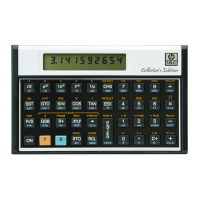50 Section 4: Statistics Functions
In some cases involving x or y data values that differ by a relatively small
amount, the calculator cannot compute s, r, linear regression, or ŷ, and
will display
Error 2
. This will not happen, however, if you normalize the
data by keying in only the difference between each value and the mean or
approximate mean of the values. This difference must be added back to
the calculations of , ŷ, and the y-intercept (L). For example, if your x-
values were 665999, 666000, and 666001, you should enter the data as
−1, 0, and 1; then add 666000 back to the relevant results.
The statistics of the data are compiled as follows:
Register Contents
R
2
n Number of data points accumulated (n also
appears in the X-register).
R
3
Σx Summation of x-values.
R
4
Σx
2
Summation of squares of x-values.
R
5
Σy Summation of y-values.
R
6
Σy
2
Summation of squares of y-values.
R
7
Σxy Summation of products of x- and y-values.
You can recall any of the accumulated statistics to the display (X-register)
by pressing l and the number of the data storage register containing
the desired statistic. If you press l z, Σx and Σy will be copied
simultaneously from R
3
and R
5
respectively, into the X-register and the Y-
register, respectively. (The sequence l z lifts the stack twice if
stack lift is enabled, once if not, and then enables stack lift.)
Example: Agronomist Silas Farmer has
developed a new variety of high-yield
rice, and has measured the plant’s yield
as a function of fertilization. Use the z
function to accumulate the data below to
find the values for Σx, Σx
2
, Σy, Σy
2
, and
Σxy for nitrogen fertilizer application (x)
versus grain yield (y).

